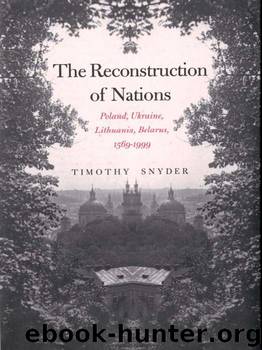The Reconstruction of Nations by Timothy Snyder

Author:Timothy Snyder [Snyder, Timothy]
Language: eng
Format: epub
ISBN: 978-0-300-12841-3
Publisher: Yale University Press
Published: 2003-03-16T16:00:00+00:00
THE UPA IN POLAND IN 1945
The UPA’s policy of ethnic cleansing, inaugurated in Volhynia in 1943, had become general practice by 1945. How did the UPA fare in these conditions, which it had helped to create? After the informal border shift of 1944, the main body of the UPA fought Soviet power in Soviet West Ukraine, its commanders regarding Poland as a peripheral field of operations. In early 1945, Iaroslav Starukh organized a new UPA command for Poland within its new westerly frontiers. Reorganization was complete by August 1945, when the new Soviet-Polish border was publicized. In 1945 in Poland, UPA units probably never numbered more than twenty-four hundred troops.47 These troops were not, with a few exceptions, the same people who had cleansed Volhynia and Galicia in 1943-44. The vast majority of UPA soldiers in what was becoming postwar Poland joined in 1944, 1945, or 1946, and fought in the regions where they lived.48 The further south and west they were in Poland, the longer it took Ukrainian nationalists to activate the UPA. The UPA fought in the Lublin region in 1943. In the Bieszczady mountains, the UPA arose in 1944. As late as fall 1945, after the German surrender and the end of the Second World War, Beskid Niski had no UPA presence, and its Lemkos were scornful of the very idea.
Khrushchev was correct in writing to Stalin that Polish partisan attacks on Ukrainian civilians helped UPA recruitment.49 The main factor, however, was the desire to avoid deportation to the Soviet Union.50 The link between the homeland and Ukrainian nationalism, never before made in many of these territories, finally became salient when Ukrainian nationalists promised to prevent deportation. This was a passage to a new universe of ideology. The OUN-Bandera was still the dominant force within Ukrainian nationalism, but after the German surrender differences between the OUN-Mel’nyk and the OUN-Bandera became less important. Veterans of SS-Galizien, supported by the OUN-Mel’nyk but opposed by the OUN-Bandera, now played a crucial role in the local UPA.51 This can be ascertained on the basis of UPA records. Mykola Kopdo deserted the SS-Galizien for the UPA in 1944, and died commanding a UPA brigade in Poland. Dmytro Karvans’kyi, a prominent OUN-Mel’nyk activist, deserted the SS-Galizien for the UPA in February 1944. He died commanding a UPA company in Poland. Mykhailo Hal’o, commander of one of the four UPA battalions in southeastern Poland, also left the SS-Galizien in 1944. Marian Lukashevich, commander of one of three UPA tactical regions in Poland, was also a veteran of SS-Galizien.52 Whatever the motives of the local Ukrainians who joined the UPA, they received their training from such officers.53 In other words, the ethnic cleansing policies of communist Poland drove its Ukrainian citizens into the arms of former Waffen-SS troops.
That said, the UPA was pursuing interests in Poland in 1945 that we can ascertain and describe. Most of its actions were designed to halt deportations, and its recruiting propaganda presented it as an organization that would defend Ukrainian homes.
Download
This site does not store any files on its server. We only index and link to content provided by other sites. Please contact the content providers to delete copyright contents if any and email us, we'll remove relevant links or contents immediately.
| Anarchism | Communism & Socialism |
| Conservatism & Liberalism | Democracy |
| Fascism | Libertarianism |
| Nationalism | Radicalism |
| Utopian |
The Secret History by Donna Tartt(18694)
The Social Justice Warrior Handbook by Lisa De Pasquale(12069)
Thirteen Reasons Why by Jay Asher(8717)
This Is How You Lose Her by Junot Diaz(6690)
Weapons of Math Destruction by Cathy O'Neil(6069)
Zero to One by Peter Thiel(5618)
Beartown by Fredrik Backman(5533)
The Myth of the Strong Leader by Archie Brown(5358)
The Fire Next Time by James Baldwin(5185)
How Democracies Die by Steven Levitsky & Daniel Ziblatt(5083)
Promise Me, Dad by Joe Biden(5029)
Stone's Rules by Roger Stone(4981)
100 Deadly Skills by Clint Emerson(4785)
A Higher Loyalty: Truth, Lies, and Leadership by James Comey(4768)
Rise and Kill First by Ronen Bergman(4643)
Secrecy World by Jake Bernstein(4584)
The David Icke Guide to the Global Conspiracy (and how to end it) by David Icke(4539)
The Farm by Tom Rob Smith(4397)
The Doomsday Machine by Daniel Ellsberg(4366)
